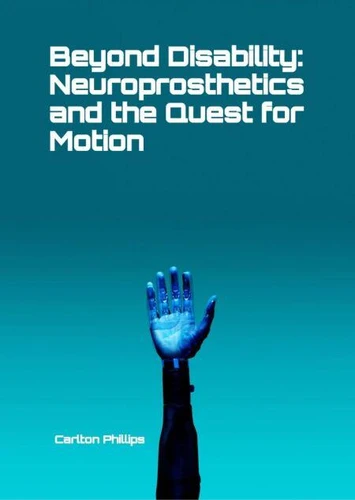Beyond Disability: Neuroprosthetics and the Quest for Motion
Par :Formats :
Disponible dans votre compte client Decitre ou Furet du Nord dès validation de votre commande. Le format ePub est :
- Compatible avec une lecture sur My Vivlio (smartphone, tablette, ordinateur)
- Compatible avec une lecture sur liseuses Vivlio
- Pour les liseuses autres que Vivlio, vous devez utiliser le logiciel Adobe Digital Edition. Non compatible avec la lecture sur les liseuses Kindle, Remarkable et Sony
 , qui est-ce ?
, qui est-ce ?Notre partenaire de plateforme de lecture numérique où vous retrouverez l'ensemble de vos ebooks gratuitement
Pour en savoir plus sur nos ebooks, consultez notre aide en ligne ici
- FormatePub
- ISBN8227263490
- EAN9798227263490
- Date de parution15/09/2024
- Protection num.pas de protection
- Infos supplémentairesepub
- ÉditeurBig Dog Books, LLC
Résumé
Beyond Disability: Neuroprosthetics and the Quest for Motion takes readers on an inspiring journey through the cutting-edge world of neuroprosthetics. This comprehensive book delves into the science, ethics, and future possibilities of technologies designed to restore movement to those affected by paralysis, limb loss, and other motor disabilities. Starting with Chapter 1: Understanding Neuroprosthetics, the book provides a clear introduction to this life-changing field, exploring how brain-machine interfaces have opened doors to unprecedented advancements in mobility.
In Chapter 2: The Science Behind Movement, readers will discover the complex biological processes involved in motion and how modern technology has harnessed this knowledge to develop neuroprosthetic devices. Chapter 3: Clinical Applications showcases real-world case studies, highlighting how neuroprosthetics are transforming patients' lives, while Chapter 4: The Human Experience emphasizes the emotional, psychological, and social impact on individuals living with these devices.
The ethical dimensions of this transformative technology are explored in Chapter 5: Ethical Considerations, addressing concerns around accessibility, autonomy, and the potential implications of merging humans and machines. Chapter 6: Technological Innovations delves into the latest breakthroughs, revealing how advancements in artificial intelligence, robotics, and materials science push the boundaries of what's possible.
In Chapter 7: The Future of Motion, the book looks forward to what lies ahead, envisioning a world where disability may be further mitigated or even eradicated through continuous technological progress. Engaging the public in these innovations is crucial, as discussed in Chapter 8: Engaging the Public, where readers learn about the role of awareness, education, and advocacy in driving acceptance and support for neuroprosthetic advancements.
Chapter 9: Investment and Innovation examines the vital role of funding, industry partnerships, and entrepreneurship in accelerating research and bringing cutting-edge neuroprosthetic solutions to market. Finally, Chapter 10: Philosophical Reflections provides a thought-provoking conclusion, questioning what it means to be human in an age where technology can reshape our physical limitations and redefine our capabilities.
This book is a must-read for those interested in neuroscience, technology, healthcare, and the profound ethical questions that arise as we push the boundaries of human motion. Whether you're a student, researcher, or simply curious about the future of mobility, Beyond Disability offers a captivating glimpse into a world where science fiction is fast becoming reality.
In Chapter 2: The Science Behind Movement, readers will discover the complex biological processes involved in motion and how modern technology has harnessed this knowledge to develop neuroprosthetic devices. Chapter 3: Clinical Applications showcases real-world case studies, highlighting how neuroprosthetics are transforming patients' lives, while Chapter 4: The Human Experience emphasizes the emotional, psychological, and social impact on individuals living with these devices.
The ethical dimensions of this transformative technology are explored in Chapter 5: Ethical Considerations, addressing concerns around accessibility, autonomy, and the potential implications of merging humans and machines. Chapter 6: Technological Innovations delves into the latest breakthroughs, revealing how advancements in artificial intelligence, robotics, and materials science push the boundaries of what's possible.
In Chapter 7: The Future of Motion, the book looks forward to what lies ahead, envisioning a world where disability may be further mitigated or even eradicated through continuous technological progress. Engaging the public in these innovations is crucial, as discussed in Chapter 8: Engaging the Public, where readers learn about the role of awareness, education, and advocacy in driving acceptance and support for neuroprosthetic advancements.
Chapter 9: Investment and Innovation examines the vital role of funding, industry partnerships, and entrepreneurship in accelerating research and bringing cutting-edge neuroprosthetic solutions to market. Finally, Chapter 10: Philosophical Reflections provides a thought-provoking conclusion, questioning what it means to be human in an age where technology can reshape our physical limitations and redefine our capabilities.
This book is a must-read for those interested in neuroscience, technology, healthcare, and the profound ethical questions that arise as we push the boundaries of human motion. Whether you're a student, researcher, or simply curious about the future of mobility, Beyond Disability offers a captivating glimpse into a world where science fiction is fast becoming reality.
Beyond Disability: Neuroprosthetics and the Quest for Motion takes readers on an inspiring journey through the cutting-edge world of neuroprosthetics. This comprehensive book delves into the science, ethics, and future possibilities of technologies designed to restore movement to those affected by paralysis, limb loss, and other motor disabilities. Starting with Chapter 1: Understanding Neuroprosthetics, the book provides a clear introduction to this life-changing field, exploring how brain-machine interfaces have opened doors to unprecedented advancements in mobility.
In Chapter 2: The Science Behind Movement, readers will discover the complex biological processes involved in motion and how modern technology has harnessed this knowledge to develop neuroprosthetic devices. Chapter 3: Clinical Applications showcases real-world case studies, highlighting how neuroprosthetics are transforming patients' lives, while Chapter 4: The Human Experience emphasizes the emotional, psychological, and social impact on individuals living with these devices.
The ethical dimensions of this transformative technology are explored in Chapter 5: Ethical Considerations, addressing concerns around accessibility, autonomy, and the potential implications of merging humans and machines. Chapter 6: Technological Innovations delves into the latest breakthroughs, revealing how advancements in artificial intelligence, robotics, and materials science push the boundaries of what's possible.
In Chapter 7: The Future of Motion, the book looks forward to what lies ahead, envisioning a world where disability may be further mitigated or even eradicated through continuous technological progress. Engaging the public in these innovations is crucial, as discussed in Chapter 8: Engaging the Public, where readers learn about the role of awareness, education, and advocacy in driving acceptance and support for neuroprosthetic advancements.
Chapter 9: Investment and Innovation examines the vital role of funding, industry partnerships, and entrepreneurship in accelerating research and bringing cutting-edge neuroprosthetic solutions to market. Finally, Chapter 10: Philosophical Reflections provides a thought-provoking conclusion, questioning what it means to be human in an age where technology can reshape our physical limitations and redefine our capabilities.
This book is a must-read for those interested in neuroscience, technology, healthcare, and the profound ethical questions that arise as we push the boundaries of human motion. Whether you're a student, researcher, or simply curious about the future of mobility, Beyond Disability offers a captivating glimpse into a world where science fiction is fast becoming reality.
In Chapter 2: The Science Behind Movement, readers will discover the complex biological processes involved in motion and how modern technology has harnessed this knowledge to develop neuroprosthetic devices. Chapter 3: Clinical Applications showcases real-world case studies, highlighting how neuroprosthetics are transforming patients' lives, while Chapter 4: The Human Experience emphasizes the emotional, psychological, and social impact on individuals living with these devices.
The ethical dimensions of this transformative technology are explored in Chapter 5: Ethical Considerations, addressing concerns around accessibility, autonomy, and the potential implications of merging humans and machines. Chapter 6: Technological Innovations delves into the latest breakthroughs, revealing how advancements in artificial intelligence, robotics, and materials science push the boundaries of what's possible.
In Chapter 7: The Future of Motion, the book looks forward to what lies ahead, envisioning a world where disability may be further mitigated or even eradicated through continuous technological progress. Engaging the public in these innovations is crucial, as discussed in Chapter 8: Engaging the Public, where readers learn about the role of awareness, education, and advocacy in driving acceptance and support for neuroprosthetic advancements.
Chapter 9: Investment and Innovation examines the vital role of funding, industry partnerships, and entrepreneurship in accelerating research and bringing cutting-edge neuroprosthetic solutions to market. Finally, Chapter 10: Philosophical Reflections provides a thought-provoking conclusion, questioning what it means to be human in an age where technology can reshape our physical limitations and redefine our capabilities.
This book is a must-read for those interested in neuroscience, technology, healthcare, and the profound ethical questions that arise as we push the boundaries of human motion. Whether you're a student, researcher, or simply curious about the future of mobility, Beyond Disability offers a captivating glimpse into a world where science fiction is fast becoming reality.






















